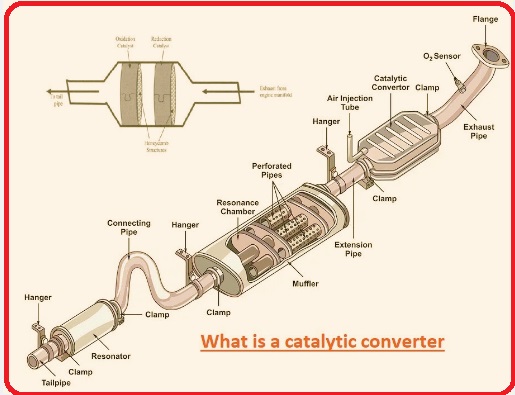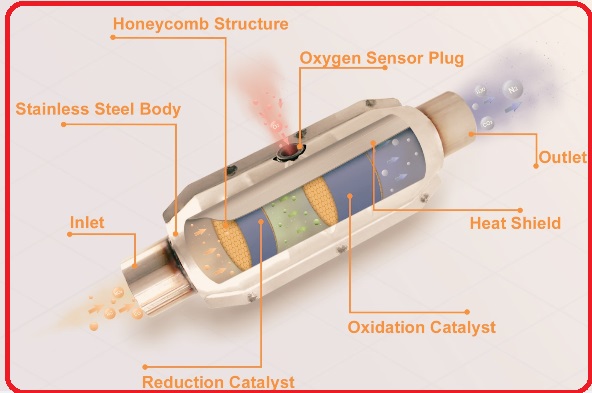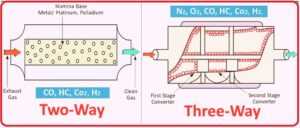The catalytic converter is a main component of a vehicle that has been used for more than fifty years, and its main function is to reduce emissions generated in a car or vehicle. A catalytic converter, also called a “cat,” is the second part of the vehicle’s system. Other components of the vehicle system include mid pipes, mufflers, tailpipes, and resonators.
In this tutorial, we cover detailed features of catalytic converters and related factors for gaining a practical working understanding. Let’s get started. What is a catalytic converter?
What is a catalytic converter?
- The catalytic converter was first used for vehicles in the mid-1970s, and after that, it was used universally. It is basically a component of the car exhaust system that is used for converting hazardous engine exhaust emissions into less harmful materials with chemical reactions.
- In a chemical reaction, carbon monoxide, hydrocarbons, and nitrogen oxides are converted into low-hazard nitrogen, carbon dioxide, and vapors.
- Fuel burned in an internal combustion engine has hydrocarbons. Hydrocarbons are the main source of ozone layer depletion and affect human health.
- Carbon monoxide and toxic nitrogen oxides are also hazards that are considered byproducts of internal combustion engines.
Construction catalytic converter
Read also What Do Struts Do On A Car
main components of a catalytic converter are as
substrate
- catalytic converter core made with a ceramic monolith that is a square-shaped structure. metallic foil monoliths made with the use of Kanthal, which has been used since it provides high heat resistance.
- The substrate of the catalytic converter provides a larger surface area. cordierite ceramic substrate part of a different catalytic converter that was invented by Rodney Bagley, Irwin Lachman, and Ronald Lewis at Corning Glass
washcoat
- washcoat is a carrier of catalytic materials and disperses materials over a larger area. For this purpose, titanium dioxide, silicone dioxide, and aluminum oxide are used.
- before applying on the core catalytic materials suspended in the washcoat. Washcoat materials are used for making rough-shaped, irregular surface areas that are larger than smooth surfaces made through a bare substrate.
Ceria or ceria-zirconia
- These are oxides that are used for oxygen storage promoters.
Catalyst
- A catalyst is a mixture of costly metals, like those taken from the platinum group. Platinum is a highly active catalyst and commonly used but not preferred highly since it causes high extra reactions and high cost.
- Palladium and rhodium are also two precious metals used. Rhodium works as a reduction catalyst, and palladium works as an oxidation catalyst, while platinum performs both reduction and oxidation.
- Copper is also used as a catalyst in some countries.
Types of catalytic converters
Two-way catalytic converter
- The 2-way converter performs two operations at the same time.
- First is the oxidation of carbon monoxide to carbon dioxide, with the chemical reaction 2CO + O₂ → 2CO₂.
- Hydrocarbon oxidation occurs for the conversion of carbon dioxide and water, CxH2x+2 + [(3x+1)/2] O₂ → xCO₂ + (x+1)H₂O Equation
- Two-way catalytic converter is normally used for diesel engines that reduce hydrocarbon and carbon monoxide emissions.
- It is also used with gasoline engines that are part of vehicles used in the USA and Canada.
- Since they do not have features for controlling nitrogen oxides, Honda uses a twin catalyst system with an NOx-reducing platinum catalyst with the air pump, which helps in the manufacturing of a three-way catalytic converter.
- Two-way catalytic converters are also used for low-cost cars used in Europe, where NOx emissions were not regulated until the use of the Euro 3 emissions standard in 2000.
Three-way catalytic converter
- 3-way catalytic converters provide some high features, like controlling nitric oxide and nitrogen emissions.
- Since 1981, a three-way converter has been used for controlling emissions in Canada and the USA. The reduction and oxidation catalyst comes in a housing, in some applications configured separately.
- 3-way catalytic converters perform 3 operations, where nitrogen oxides are reduced to nitrogen.
C+2NO2→CO2+2NO
CO+NO→CO2+1/2N2
2CO+NO2→2CO2+1/2N2
H2+NO→H2O+1/2N2
What Does a Catalytic Converter Do?
- A catalytic converter is a catalyst that reduces harmful molecules released through the exhaust of the engine and transforms them into low-hazard steam.
- Its main operation is to reduce the effect of the combination of harmful molecules in gases released through vehicles before releasing them to the outside.
- location of the catalytic converter is below the car. Its design is like a metallic box. Two pipes connected with a catalytic converter.
- Pipes and catalysts are used in catalytic converters when hazardous gases are converted to safe ones before emission into the environment.
- Gases go into the input pipe that is connected to the car engine. Gases go to the converter and are shot over the catalyst and burn through chemicals, making pollutants.
- The last catalytic converter releases fewer hazardous gases, and these gases are released through the 2nd pipe, known as the output pipe, which is connected with the tailpipe of the car
Catalytic Converter Working
Two processes occur through catalysis as exhaust gases move through the heated catalytic converter.
- The reduction catalyst is the first catalytic process that minimizes harmful nitrogen oxides, with nitrogen oxides breaking into nitrogen and oxygen molecules.
- In the second phase, catalytic oxidation occurs in the oxidation catalyst, where unburned hydrocarbons burn with carbon monoxide through the metallic catalyst on the converter.
Symptoms of a Bad Catalytic Converter
Common signs of a bad catalytic converter are as follows:
Smell From Exhaust
- If you face a rotten egg smell from the exhaust, that means the catalytic converter is affected. It occurs due to gasoline engines; since gasoline engines use sulfur, it is converted into hydrogen sulfide, which is used for fuel.
- main working of a catalytic converter is to remove hazardous hydrogen sulfide and convert it into less hazardous sulfide oxide.
- If the converter is not working well, raw gases from hydrogen sulfide to car exhaust move and smell like rotten egg releases.
The car’s check engine light is on.
Read also How to Add Water to Car Battery
- If the catalytic converter is not working well, the Check Engine Light will be on. Oxygen sensors exist in advanced vehicles, and these sensors are used for checking the working of the catalytic converter under exhaust gas conditions.
- If the vehicle is releasing exhaust gases with faulty working of catalytic, the check engine light will be on due to a damaged oxygen sensor that indicates to drivers any fault.
- There are many chances that the driver will not detect the issue. For this purpose, diagnostic scan tools like P0420, P0421, and P0430 are common fault codes for finding converter damage.
Improper Acceleration
- The main sign of a vehicle that comes with a clogged catalytic converter is an engine not work well. In a catalytic converter, the catalyst core is made with a honeycomb design. Through carbon building and converter inner parts melting, fuel generating high heat causes incomplete blockage.
- Minor stoppage for exhaust flow affects the engine’s performance. If you have a blocked catalytic converter, acceleration is affected while driving on hilly roads.
- To remove clogs, clean the converter, and it can start operating.
Failed smog test
- After some time, in some parts of the USA, there is a need to pass a smog test to find vehicles that burn fuel accurately and keep poisonous gases away from the air.
- If the converter is not working, it causes a failed smog test.
- It can test through the OBD2 port for vehicles made after 1996 or with a hose on the tailpipe, with measurement of poisonous gas concentrations for vehicles made before 1996.
Noise
- If the catalyst substrate structure is damaged, facing high heat causes a rattling sound when the engine is idling. A rattling sound is observed at the time of ignition.
- catalytic converter needed to be separated from the exhaust system when facing this noise since a loose part fell into the exhaust pipe and got stuck in the muffler, which blocked exhaust flow and caused stalling and the vehicle to stall.
Low Fuel Efficiency
- If your catalytic converter is not working well, it causes low fuel efficiency and uses more fuel.
- engine of a vehicle uses an O₂ sensor for regulating fuel in the engine’s combustion chamber. If blockage is causing high pressure in the exhaust system, the O₂ sensor will not give accurate values about air moving into the system.
- In the result engine, sending high fuel to a fuel system that is not in use.
How Long Do Catalytic Converters Last?
- Normally, the working life of a catalytic converter is a minimum of 100,000 miles. After that, they start wearing out. Normally, repairing the catalytic converter is not possible, so we needed a replacement.
- Normally, the charge for a new catalytic converter is 2500 dollars or higher for components and labor.
How much for Catalytic Converter Replacement?
- Catalytic converter replacement cost is based on damage and model. Catalytic converter normal replacement charges are 300 to 3000 dollars, and can be high.
- Cost changes according to vehicle type, converter model, and labor charges.
- Universal converters are lower in cost than direct-fit OEM parts, and their charges are in the range of $70 to $130 per hour.
Tips To Prevent Catalytic Converter Theft
For the construction of a catalytic converter, Costly metals like platinum and palladium are used, which is the cause of converter stealing.
Catalytic converter theft is common for vehicles that park in open areas where easy access is possible.
Follow these steps to prevent catalytic converter theft.
- Try to park your car in a lighted area close to the building if a garage is not available.
- Strongly weld the catalytic converter to the frame for prevent a difficult disconnection.
- Use an add-on to protect the converter with a metal guard.
- Use car alarms that come with motion vibration sensors for operating the alarm.
- mentioned the last 6 numbers of the VIN on the converter, which helps to detect the theft of the converter.
How the Government Is Helping To Prevent Converter Theft
- In Ohio, lawmakers introduced a bill to ban catalytic converters without proof of ownership. Arizona started operations like “Operation Heavy Metal” for minimizing converter theft.
- Legal departments started anti-theft programs. If the license plate number is etched, that helps the converter easily trace and can lead to theft.
Do All Cars Have Catalytic Converters?
- If your vehicle comes with a combustion engine that was built after 1975, it comes with a catalytic converter to fulfill the Clean Air Pact, according to the U.S. Environmental Protection Agency.
- But now vehicles having combustion engines require catalytic converters important for restricting the emission of fuel-injected motors that cause pollution through hazardous materials like nitrogen dioxide, hydrocarbons, and carbon monoxide.
- If not, use a converter, and these emissions can affect the environment badly. Through the catalytic converter, exhaust gases are converted to less hazardous substances that convert them into nitrogen, carbon dioxide, and water vapor.
- A gas vehicle currently used comes with a minimum of one catalytic converter, and a hybrid also has a catalytic converter due to the engine.
- Electric vehicles do not have converters since they do not release hazardous emissions.
Why Does a Car Have More Than One Catalytic Converter?
- Most vehicles come with one catalytic converter, but two are not commonly seen with a vehicle.
- A dual exhaust vehicle functions with two exhaust pipes; using two converters gives accurate exhaust flow.
- Vehicles can come with multiple converters to fulfill emission demands. In some conditions, emission needs to be transformed double for hazard-free emissions.
Can a Car Run Without a Catalytic Converter?
- A car can run without a catalytic converter, but it is not recommended. since it reduces vehicle performance, causes high emissions, and does not fulfill emission tests.








